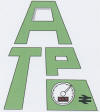 Chiltern Line ATP Pilot
Scheme
Chiltern Line ATP Pilot
Scheme
 Chiltern Line ATP Pilot
Scheme
Chiltern Line ATP Pilot
Scheme
During the delivery of the new Class 165 DMUs to Aylesbury depot in 1990, for use on the lines between Marylebone, Aylesbury and Bicester, the Alcatel SEL system was fitted to the class 165 fleet and was being put through its paces by GEC Alstom Signalling Ltd (GASL). Alcatel SEL of Stuttgart, Germany had already designed and installed the successful LZB continuous loop system in use in Germany. The system in UK was a development of this and eventually became known as SelcabŪ. This system is installed in a number of locations around Europe, notably at each end of the standard gauge high speed AVE line between Madrid and Seville in Spain in addition to LZB on the main route. 39 Class 165 units, both two and three car sets, were fitted with the system at Aylesbury depot as they were being delivered. One unit was allocated as a test train (it had not been fully fitted with seating but had got a vital piece of kit - a kettle!) and this ran between Aylesbury and Marylebone trialling the system. The lines between Marylebone and Princes Risborough were fitted with the lineside equipment as was the single line between Princes Risborough and Aylesbury which included Marsh Lane open level crossing. The fitting of the system to the LUL line between Neasden Junction and Amersham was delayed as it was proving difficult to arrange possessions on LUL. Eventually it became impossible hence the whole Class 165 fleet was retro-fitted with tripcocks for use over the LUL section! A triumph for 1909 technology. In a similar manner to the HST's, the units were equipped with an antenna which received information from the track-mounted loops, a tachometer to record distance travelled, a driver's display to convey information to the driver and a data entry unit to allow the driver's PIN number and certain parameters to be entered into the on-board computer as required. The computer was more compact than the ACEC type and was mounted in the cab beneath the 'secondman's' side desk. Track equipment was fitted between Marylebone and Princes Risborough with a few 'gaps' south of High Wycombe but later it was completed throughout utilising the redundant equipment resulting from the inability to fit the LUL section. North of Princes Risborough it was only fitted around Bicester as there were few if any signals on the single line between the two locations, although full train protection was maintained throughout. The SEL track equipment consisted of a loop of cable located in rear of each signal. The cables were run with one side of the loop clipped to the sleepers in the centre of the four foot and the return ran along the rail foot (on flat bottom rail) or along the outer end of the sleepers (on bullhead rail). The loops varied in length dependent upon the local requirements e.g. longer loops were fitted on the approach to junctions etc. The advantage of the SEL system was that the loops had crossovers at pre-determined distances (usually about every 50m) which served to reset any anomaly in the tachometer's distance measurement thereby ensuring accurate location approaching the signal. A similar system is now fitted to the LU Northern and Jubilee Lines. As the tests and trials were prolonged the original unit used as a test train returned to York to be fitted out and we used ECS units from Marylebone out and back from the sidings at Marylebone each day. The trains ran over all parts of the line except between Princes Risborough and Bicester as it was operationally very difficult to obtain a train path between services in the days of the single line. We stopped at the Horse & Jockey hotel in Aylesbury later moving to the Holiday Inn - Garden Court just next to the local football ground. The work in Aylesbury was eventually to last nearly seven years - not bad for a job which was originally planned to last six weeks! I think we ate in every curry house in Aylesbury over the years. Click on the image for a bigger picture - all pictures are from the author's collection unless otherwise credited |